
The Kassites were people of the ancient Near East, who controlled Babylonia after the fall of the Old Babylonian Empire c. 1531 BC and until c. 1155 BC.
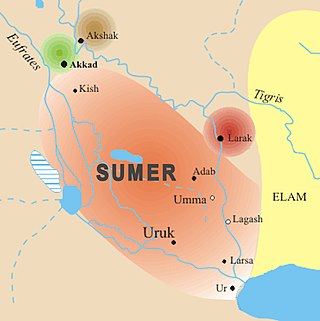
Umma (Sumerian: 𒄑𒆵𒆠ummaKI; in modern Dhi Qar Province in Iraq, was an ancient city in Sumer. There is some scholarly debate about the Sumerian and Akkadian names for this site. Traditionally, Umma was identified with Tell Jokha. More recently it has been suggested that it was located at Umm al-Aqarib, less than 7 km to its northwest or was even the name of both cities. One or both were the leading city of the Early Dynastic kingdom of Gišša, with the most recent excavators putting forth that Umm al-Aqarib was prominent in EDIII but Jokha rose to preeminence later. The town of KI.AN was also nearby. KI.AN, which was destroyed by Rimush, a ruler of the Akkadian Empire. There are known to have been six gods of KI.AN including Gula KI.AN and Sara KI.AN.

Mesannepada (Sumerian: 𒈩𒀭𒉌𒅆𒊒𒁕, Mesannipàdda [MES-AN-NE2-PAD3-DA]), Mesh-Ane-pada or Mes-Anne-pada ("Youngling chosen by An") was the first king listed for the First Dynasty of Ur (c. 26th century BC) on the Sumerian king list. He is listed to have ruled for 80 years, having overthrown Lugal-kitun of Uruk: "Then Unug (Uruk) was defeated and the kingship was taken to Urim (Ur)". In one of his seals, found in the Royal Cemetery at Ur, he is also described as king of Kish.
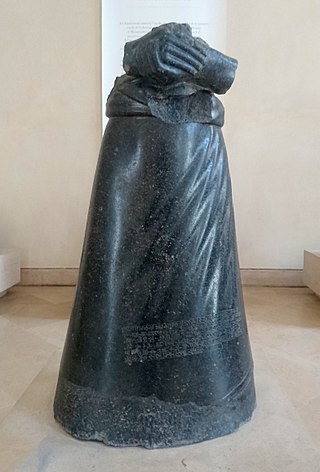
Manishtushu (Man-ištušu) c. 2270-2255 BC was the third king of the Akkadian Empire, reigning 15 years from c. 2270 BC until his death in c. 2255 BC. His name means "Who is with him?". He was the son of Sargon the Great, the founder of the Akkadian Empire, and he was succeeded by his son, Naram-Sin who also deified him posthumously. A cylinder seal, of unknown provenance, clearly from the reign of Naram-Sin or later, refers to the deified Manishtushu i.e. "(For) the divine Man-istusu: Taribu, the wife of Lugal-ezen, had fashioned". Texts from the later Ur III period show offerings to the deified Manishtushu. The same texts mention a town of ᵈMa-an-iš-ti₂-su where there was a temple of Manishtushu. This temple was known in the Sargonic period as Ma-an-iš-t[i-s]uki.

Shu-turul was the last king of the Akkadian Empire, ruling for 15 years according to the Sumerian king list. It indicates that he succeeded his father Dudu. A few artifacts, seal impressions etc. attest that he held sway over a greatly reduced Akkadian territory that included Kish, Tutub, Nippur, and Eshnunna. The Diyala river also bore the name "Shu-durul" at the time.
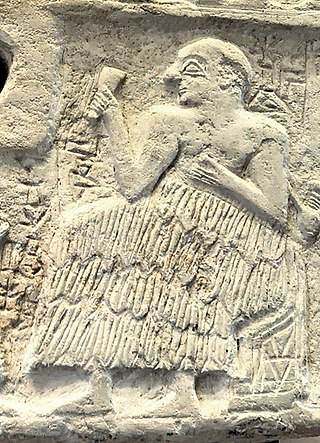
Ur-Nanshe also Ur-Nina, was the first king of the First Dynasty of Lagash in the Sumerian Early Dynastic Period III. He is known through inscriptions to have commissioned many building projects, including canals and temples, in the state of Lagash, and defending Lagash from its rival state Umma. He was probably not from royal lineage, being the son of Gunidu who was recorded without an accompanying royal title. He was the father of Akurgal, who succeeded him, and grandfather of Eannatum. Eannatum expanded the kingdom of Lagash by defeating Umma as illustrated in the Stele of the Vultures and continued the building and renovation of Ur-Nanshe's original buildings.

The first dynasty of Ur was a dynasty of rulers from the city of Ur in ancient Sumer who reigned c. 2600 – c. 2340 BC. Ur I is part of the Early Dynastic III period of ancient Mesopotamia. It was preceded by the earlier First Dynasty of Kish and the First Dynasty of Uruk.

A kudurru was a type of stone document used as a boundary stone and as a record of land grants to vassals by the Kassites and later dynasties in ancient Babylonia between the 16th and 7th centuries BC. The original kudurru would typically be stored in a temple while the person granted the land would be given a clay copy to use to confirm legal ownership. Kudurrus are often linked to what are usually called "ancient kudurrus", land grant stones from the third millennium which serve a similar purpose though the word kudurru did not emerge until the 2nd millennium.

Enmebaragesi (Sumerian: 𒂗𒈨𒁈𒄄𒋛Enmebárgisi [EN-ME-BARA2-GI4-SE]) originally Mebarasi (𒈨𒁈𒋛) was the penultimate king of the first dynasty of Kish and is recorded as having reigned 900 years in the Sumerian King List. Like his son and successor Aga he reigned during a period when Kish had hegemony over Sumer.a Enmebaragesi signals a momentous documentary leap from mytho-history to history, since he is the earliest ruler on the king list whose name is attested directly from archaeology.

Rimush c. 2279–2270 BC was the second king of the Akkadian Empire. He was the son of Sargon of Akkad and Queen Tashlultum. He was succeeded by his brother Manishtushu, and was an uncle of Naram-Sin of Akkad. Naram-Sin posthumously deified Sargon and Manishtushi but not his uncle. His sister was Enheduana, considered the earliest known named author in world history. Little is known about his brother Shu-Enlil. There was a city, Dur-Rimuš, located near Tell Ishchali and Khafajah. It was known to be a cult center of the storm god Adad.
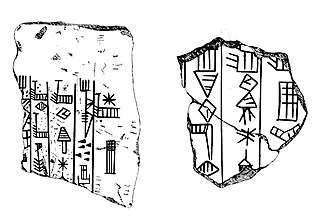
Enshakushanna, or Enshagsagana, En-shag-kush-ana, Enukduanna, En-Shakansha-Ana, En-šakušuana was a king of Uruk around the mid-3rd millennium BC who is named on the Sumerian King List, which states his reign to have been 60 years. He conquered Hamazi, Akkad, Kish, and Nippur, claiming hegemony over all of Sumer.

Mesilim, also spelled Mesalim, was lugal (king) of the Sumerian city-state of Kish.

Aga commonly known as Aga of Kish, was the twenty-third and last king in the first dynasty of Kish during the Early Dynastic I period. He is listed in the Sumerian King List and many sources as the son of Enmebaragesi. The Kishite king ruled the city at its peak, probably reaching beyond the territory of Kish, including Umma and Zabala.
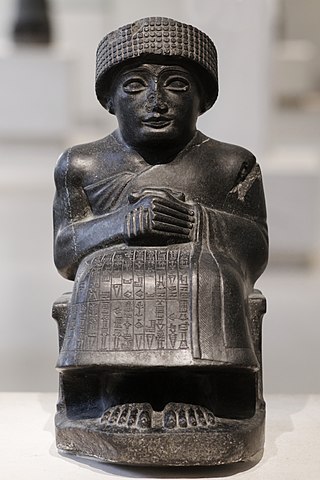
The art of Mesopotamia has survived in the record from early hunter-gatherer societies on to the Bronze Age cultures of the Sumerian, Akkadian, Babylonian and Assyrian empires. These empires were later replaced in the Iron Age by the Neo-Assyrian and Neo-Babylonian empires. Widely considered to be the cradle of civilization, Mesopotamia brought significant cultural developments, including the oldest examples of writing.

Enakalle or Enakalli was the king of Umma circa 2500–2400 BC, a Sumerian city-state, during the Early Dynastic III period. His reign lasted at least 8 years.

The Blau Monuments are a pair of inscribed stone objects from Mesopotamia now in the British Museum. They are commonly thought to be a form of ancient kudurru.

Lugalshaengur, , was ensi (governor) of the Sumerian city-state of Lagash.
Meskigal was a Sumerian ruler of the Mesopotamian city of Adab in the mid-3rd millennium BCE, probably circa 2350 BCE. He was contemporary with Lugal-zage-si and the founder of the Akkadian Empire, Sargon of Akkad.

Lugal-kisalsi, also Lugaltarsi was a King of Uruk and Ur who lived towards the end of the 25th century BCE, succeeding his father Lugal-kinishe-dudu, according to contemporary inscriptions, although he does not appear in the Sumerian King List. In one of his inscriptions, he appears as "Lugalkisalsi, the first-born son of Lugalkigenedudu, king of Uruk and Ur".

Lugal-ushumgal was a Sumerian ruler of Lagash ("Shirpula"), c. 2230 – c. 2210 BCE. Several inscriptions of Lugal-ushumgal are known, particularly seal impressions, which refer to him as governor of Lagash and at the same time a vassal of the Akkadian Empire rulers Naram-Sin and his successor Shar-Kali-Sharri.


























